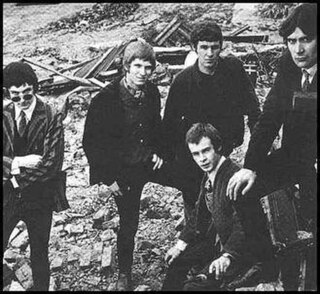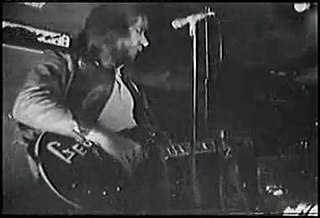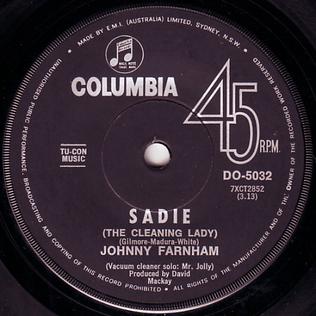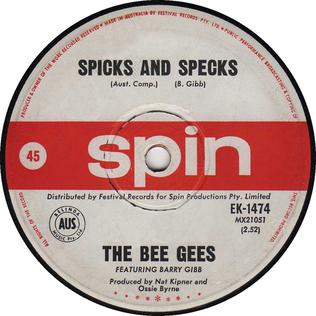
The Loved Ones were an Australian rock band formed in 1965 in Melbourne following the British Invasion. The line-up of Gavin Anderson on drums, Ian Clyne on organ and piano, Gerry Humphrys on vocals and harmonica, Rob Lovett on guitar and Kim Lynch on bass guitar recorded their early hits. Their signature song, "The Loved One", reached number two on Australian singles charts and was later covered by INXS. In 2001 it was selected as number six on the Australasian Performing Right Association's (APRA) list of Top 30 Australian songs of all time. Their debut album, The Loved Ones' Magic Box, was released late in 1967 and included their other hit singles, "Ever Lovin' Man" and "Sad Dark Eyes". They disbanded in October 1967 and, although the band's main career lasted only two years, they are regarded as one of the most significant Australian bands of the 1960s. They reformed for a short tour in 1987 which provided the album Live on Blueberry Hill. Humphrys lived in London from the mid-1970s until his death on 4 December 2005. On 27 October 2010, the Loved Ones were inducted into the Australian Recording Industry Association (ARIA) Hall of Fame.

The Twilights were an Australian rock band, which formed in Adelaide in 1964 by Peter Brideoake on rhythm guitar, John Bywaters on bass guitar, Clem "Paddy" McCartney and Glenn Shorrock both on lead vocals. They were joined by Terry Britten on lead guitar and Laurie Pryor on drums within a year. Heavily influenced by the British Invasion, they became a significant Australian band during the mid-1960s. They were noted for their musicianship, on-stage humour and adoption of overseas sounds and trends. Their most popular single is a cover version of "Needle in a Haystack", which topped the Go-Set singles chart in 1966. Also in that year, they won the Hoadley's Battle of the Sounds competition and were awarded a trip to London.
Matt Flinders is a former singer and TV presenter who rose to prominence in the late 1960s in Australia. He had top 5 hit singles with his cover versions of "Picking Up Pebbles" (1969) and "Butterfly" (1971). He hosted his own variety shows, The Matt Flinders Show (1972) and Matt Flinders and Friends (1973) on ABC-TV.
Go-Set was the first Australian pop music newspaper, published weekly from 2 February 1966 to 24 August 1974, and was founded in Melbourne by Phillip Frazer, Peter Raphael and Tony Schauble. Widely described as a pop music "bible", it became an influential publication, introduced the first national pop record charts and featured many notable contributors including fashion designer Prue Acton, journalist Lily Brett, rock writer / band manager Vince Lovegrove, music commentator Ian "Molly" Meldrum, rock writer / music historian Ed Nimmervoll and radio DJ Stan Rofe. It spawned the original Australian edition of Rolling Stone magazine in late 1972.
Ronald Leslie BurnsAM is an Australian retired rock singer-songwriter and musician.

Lobby Loyde, also known as John Barrie Lyde or Barry Lyde, was an Australian rock music guitarist, songwriter and producer.
Jeffrey Travis Andrew Phillips is an Australian TV show host, personality, musical theatre actor and pop singer active from 1966 to the early 1990s. As a pop singer, he had a Top 40 hit on the Go-Set singles chart with a cover version of The Shirelles' 1961 hit, "Baby It's You". At the Logie Awards of 1970, he won the Best New Talent category for hosting his own ABC TV pop show, Sounds Like Us. In the early 1970s he hosted a series of teen pop music shows, Happening '71 and Happening '72. In July 1972 Phillips won a song prize at the Fifth Olympiad of Song, held in Athens, performing his self-written work, "Gloria"; the prize money was 100,000 drachmae. Although he issued further singles, until the early 1980s, he had no other national Top 40 chart success. From July 1985 to October 1987 he appeared in the Australian stage production of Cats in the role of Rum Tum Tugger in both the Sydney run and the Melbourne season; he also performed on the original Australian cast album.
The Vibrants were an Australian pop rock group that started as Bobby James and the Vibrants in Adelaide in 1962. James, their lead vocalist, left in 1965 to form the Bobby James Syndicate. As the Vibrants, two of their singles peaked in Go-Set Australian National Charts top 20: their cover versions of "Something About You Baby" and "My Prayer" (September). At the end of 1973the Vibrants disbanded.

"Sadie (The Cleaning Lady)" was Australian pop singer Johnny Farnham's first solo single. The novelty song was released in November 1967 and was No. 1 on the Go-Set National Singles Charts for five weeks in early 1968 (six weeks on the Australian charts in 1968 based on the Kent Music Report). It was the largest-selling single in Australia by an Australian artist in the 1960s.
Ross D. Wyllie is a retired Australian pop music singer, television presenter and producer, most active in the 1960s and 1970s. Wyllie had a top 20 hit with his cover of Ray Stevens' song "Funny Man" and an Australian No. 1 with "The Star", both in 1969.

"Spicks and Specks" is a song by the Bee Gees, written by Barry Gibb. When the song was released in September 1966, the single reached No. 4 on the Go-Set Australian National Top 40, and when the song was released in other countries in February 1967, it reached No. 28 in Germany, No. 2 in the Netherlands and No. 1 in New Zealand.
The Australian 1970 Radio Ban or 1970 Record Ban was a "pay for play" dispute in the local music industry that lasted from May until October. During this period, a simmering disagreement between commercial radio stations – represented by the Federation of Australian Radio Broadcasters (FARB) – and the six largest record labels – represented by Australasian Performing Right Association (APRA) – resulted in major United Kingdom and Australian pop songs being refused airplay. The government-owned Australian Broadcasting Corporation – which had its own copyright and royalty arrangement with recording and music publishing companies – did not take part in the dispute. The ban did not extend to releases by American artists. Some radio disc jockeys, such as Stan Rofe, defied the ban by playing songs according to their personal tastes.
John Howard Chester is an Australian singer-songwriter, who started his career in October 1959 with group The Jaywoods singing rock music and in 1969 changed to country music. He toured nationally with the Beatles, Roy Orbison, the Everly Brothers, Kenny Rogers, Johnny Cash, Tammy Wynette and Charley Pride. During his career he has led various groups including Johnny Chester and The Chessmen, Johnny Chester and Jigsaw, Johnny Chester and Hotspur. With Jigsaw he had five top 30 hit singles, "Gwen (Congratulations)" (1971), "Shame and Scandal", "Midnight Bus", "World's Greatest Mum" and "She's My Kind of Woman" (1974).
Somebody's Image were an Australian pop and R&B band formed in 1966, which included Russell Morris on lead vocals. Their highest charting single is a cover version of Joe South's "Hush", which peaked at number 14 on the Go-Set National Top 40. Morris left in 1968 to start his solo career and the group disbanded in the following year.
The Groove was an Australian R&B, pop group which formed in early 1967 with the lineup of Geoff Bridgford on drums, Jamie Byrne on bass guitar, Tweed Harris on keyboards, Rod Stone on guitar and Peter Williams on lead vocals and guitar. In December 1967 their single, "Simon Says", peaked at No. 17 on the Go-Set National Top 40 Singles Chart. They followed with "Soothe Me", which peaked at No. 14 in April 1968. Also in April they released their self-titled debut album. In July that year they won the national final of the Hoadley's Battle of the Sounds competition with the prize including a trip to London. They relocated there in March 1969, and early the following year they changed their name to Eureka Stockade, they disbanded in 1971. On 13 October 2004 Tweed Harris died of throat cancer, aged 63.
Liv Maessen is an Australian pop singer who had hits in the early 1970s with "The Love Moth", "Knock, Knock Who's There?" and "Snowbird". In 1969, Maessen had finished second in the New Faces talent show. Her prize included a recording contract with Ron Tudor's Fable Records which released her albums, Live for Life (1971) and Best of Liv Maessen (1974). She won the 1971 Logie Award for 'Best New Talent'. In the Go-Set Pop Poll, Maessen was voted in the top 5 as most popular female vocalist in both 1970 and 1971. For her single "Knock, Knock Who's There?", Maessen became the first Australian female artist to be awarded a gold record certificate. After her recording career, Maessen turned to cabaret and club work by the mid-1970s.
Ronald Stewart Tudor MBE was an Australian music producer, engineer, label owner and record industry executive. He started his career with W&G Records in 1956 as a sales representative; he became their in-house producer and A&R agent before leaving in 1966.
Beverley Anne Harrell, is an Australian pop singer, most famous for her 1966 Australian hit "What Am I Doing Here with You?".
MPD Ltd or M. P. D. Limited were an Australian pop music band formed in 1965 by core members Mike Brady on lead vocals and guitar, Pete Watson on bass guitar and lead vocals, and Danny Finley on drums. They used their first initials to provide the name. Their popular singles were "Little Boy Sad" and "Lonely Boy" (October). MPD Ltd issued an album, The Best of MPD Ltd, in 1966 on Go!! Records before disbanding in 1967. Pete Watson died of an illness on 30 April 1972.
"The Star" or "(Here Comes) The Star" is a single by Australian pop music singer Ross D. Wyllie, released in September 1969. Written by Johnny Young and produced by Bob Foster for Festival. It reached number one on the Go-Set National Top 40. It was covered by British pop group, Herman's Hermits, as "Here Comes the Star", in November, which reached No. 33 on the UK singles chart.





